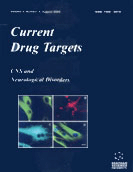Abstract
The structural heterogeneity, the ubiquity of anatomical distribution, and the demonstrated modulation of biological functions is consistent with the view that nicotinic cholinergic signaling plays a key regulatory role in the brain and influences a number of neuronal processes including sensory processing, motor activity, and cognitive function. It has become evident that perturbation of nicotinic cholinergic neurotransmission can result in diverse CNS pathologies providing the potential for therapeutic intervention in a number of neurodegenerative, neuropsychiatric and neurological disorders. This review will provide a status on the rationale for neuronal therapies targeting neuronal nicotinic receptors (nAChRs) and discusses the multifaceted beneficial effects than can be achieved through manipulation of cholinergic pharmacology. Recent advances and issues relating to rational drug design based on the structure of acetylcholine binding protein are discussed.
Keywords: Alzheimers disease, Parkinsons Disease, Lewy Body Dementia, Tourettes syndrome, Attention Deficit Disorder, Autosomal Dominant, Nocturnal Frontal Lobe Epilepsy
Current Drug Targets - CNS & Neurological Disorders
Title: Targeting Neuronal Nicotinic Receptors: a Path to New Therapies
Volume: 1 Issue: 4
Author(s): Merouane Bencherif and Jeffrey D. Schmitt
Affiliation:
Keywords: Alzheimers disease, Parkinsons Disease, Lewy Body Dementia, Tourettes syndrome, Attention Deficit Disorder, Autosomal Dominant, Nocturnal Frontal Lobe Epilepsy
Abstract: The structural heterogeneity, the ubiquity of anatomical distribution, and the demonstrated modulation of biological functions is consistent with the view that nicotinic cholinergic signaling plays a key regulatory role in the brain and influences a number of neuronal processes including sensory processing, motor activity, and cognitive function. It has become evident that perturbation of nicotinic cholinergic neurotransmission can result in diverse CNS pathologies providing the potential for therapeutic intervention in a number of neurodegenerative, neuropsychiatric and neurological disorders. This review will provide a status on the rationale for neuronal therapies targeting neuronal nicotinic receptors (nAChRs) and discusses the multifaceted beneficial effects than can be achieved through manipulation of cholinergic pharmacology. Recent advances and issues relating to rational drug design based on the structure of acetylcholine binding protein are discussed.
Export Options
About this article
Cite this article as:
Bencherif Merouane and Schmitt D. Jeffrey, Targeting Neuronal Nicotinic Receptors: a Path to New Therapies, Current Drug Targets - CNS & Neurological Disorders 2002; 1 (4) . https://dx.doi.org/10.2174/1568007023339094
| DOI https://dx.doi.org/10.2174/1568007023339094 |
Print ISSN 1568-007X |
| Publisher Name Bentham Science Publisher |
Online ISSN 1568-007X |
 3
3Related Articles
-
Methylphenidate (Ritalin): What Makes it so Widely Prescribed During the Last 60 Years?
Current Drug Therapy Reacting to Stress: Radical Cellular Pathways for Novel Drug Development
Current Neurovascular Research Glycobiology of Neural Stem Cells
CNS & Neurological Disorders - Drug Targets Neuromodulation of Hippocampal Synaptic Plasticity, Learning, and Memory by Noradrenaline
Central Nervous System Agents in Medicinal Chemistry Pharmacological Regulators of Intracellular Calcium Release Channels
Current Pharmaceutical Design Association of Oxidative Stress to the Genesis of Anxiety: Implications for Possible Therapeutic Interventions
Current Neuropharmacology Formulation of Extended-Release Beads of Lamotrigine Based on Alginate and <i>Cassia fistula</i> Seed Gum by QbD Approach
Current Drug Delivery Valproic Acid As Anti-Cancer Drug
Current Pharmaceutical Design Truly “Rational” Polytherapy: Maximizing Efficacy and Minimizing Drug Interactions, Drug Load, and Adverse Effects
Current Neuropharmacology Adenosine and Stroke: Maximizing the Therapeutic Potential of Adenosine as a Prophylactic and Acute Neuroprotectant
Current Neuropharmacology Pharmacology of Ivabradine and the Effect on Chronic Heart Failure
Current Topics in Medicinal Chemistry Tau Pathology and Future Therapeutics
Current Alzheimer Research A Review of Recent Patents on the ASICs as a Key Drug Target
Recent Patents on Biotechnology ABC Transporters and Drug Resistance in Patients with Epilepsy
Current Pharmaceutical Design Recent Patents and Discovery of Anti-inflammatory Agents from Marine Source
Recent Patents on Inflammation & Allergy Drug Discovery Growth Factors and Astrocytes Metabolism: Possible Roles for Platelet Derived Growth Factor
Medicinal Chemistry Liposomes as Versatile Platform for Cancer Theranostics: Therapy, Bio-imaging, and Toxicological Aspects
Current Pharmaceutical Design Potential Impurities of the Anti-epileptic Drug, Clobazam: Synthesis and Characterization
Letters in Organic Chemistry Benzimidazole Derivatives as Centerally Acting Agents
Current Drug Therapy Current Quest in Natural Bioactive Compounds for Alzheimer’s Disease: Multi-Targeted-Designed-Ligand Based Approach with Preclinical and Clinical Based Evidence
Current Drug Targets


















